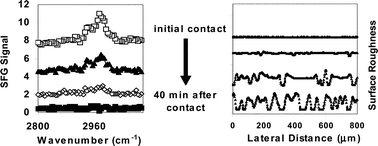Sum frequency generation (SFG) vibrational spectroscopy has been applied to investigate and compare the chemical structures of poly(ethyl methacrylate)
(PEMA) and poly(ethyl acrylate)
(PEA) in air, in water, and in a non-polar solvent, FC-75. SFG spectra from both polymer surfaces in air are dominated by vibrational modes from the ester ethyl side groups. The average orientation of these ester ethyl groups on the two polymer surfaces is slightly different. In water, the two polymers show markedly different restructuring behavior. The ester ethyl side chains on the PEMA surface in water reorient to tilt more toward the surface, yet remain ordered. Such a restructuring of the PEMA surface in water is reversible. However, no SFG signal was detected from the PEA/water interface, showing that the surface of PEA becomes disordered upon contacting water, and this process is irreversible. SFG results collected from the C![[double bond, length as m-dash]](https://www.rsc.org/images/entities/char_e001.gif) O range indicate that hydrogen bonding is observed for both polymer/water interfaces, but the order of C
O range indicate that hydrogen bonding is observed for both polymer/water interfaces, but the order of C![[double bond, length as m-dash]](https://www.rsc.org/images/entities/char_e001.gif) O at the PEA/water interface is much lower than that at the PEMA/water interface. Supplemental experiments support our hypothesis that the PEA surface becomes rough and loses order gradually as it interacts with water. We have demonstrated, for the first time, that the loss of surface structural order is due to the interaction between soft PEA chains with water molecules followed by reorganization of the polymer backbone. This causes the polymer surface to become rough and disordered. However, the surface structures of PEMA and PEA in FC-75 are similar and are also similar to those in air. This indicates that not only Tg, but also the contacting medium plays an important role in determining the surface restructuring behavior of polymer materials.
O at the PEA/water interface is much lower than that at the PEMA/water interface. Supplemental experiments support our hypothesis that the PEA surface becomes rough and loses order gradually as it interacts with water. We have demonstrated, for the first time, that the loss of surface structural order is due to the interaction between soft PEA chains with water molecules followed by reorganization of the polymer backbone. This causes the polymer surface to become rough and disordered. However, the surface structures of PEMA and PEA in FC-75 are similar and are also similar to those in air. This indicates that not only Tg, but also the contacting medium plays an important role in determining the surface restructuring behavior of polymer materials.

You have access to this article
 Please wait while we load your content...
Something went wrong. Try again?
Please wait while we load your content...
Something went wrong. Try again?
![[double bond, length as m-dash]](https://www.rsc.org/images/entities/char_e001.gif) O range indicate that hydrogen bonding is observed for both
O range indicate that hydrogen bonding is observed for both ![[double bond, length as m-dash]](https://www.rsc.org/images/entities/char_e001.gif) O at the PEA/water interface is much lower than that at the PEMA/water interface. Supplemental experiments support our hypothesis that the PEA surface becomes rough and loses order gradually as it interacts with
O at the PEA/water interface is much lower than that at the PEMA/water interface. Supplemental experiments support our hypothesis that the PEA surface becomes rough and loses order gradually as it interacts with 

 Please wait while we load your content...
Please wait while we load your content...